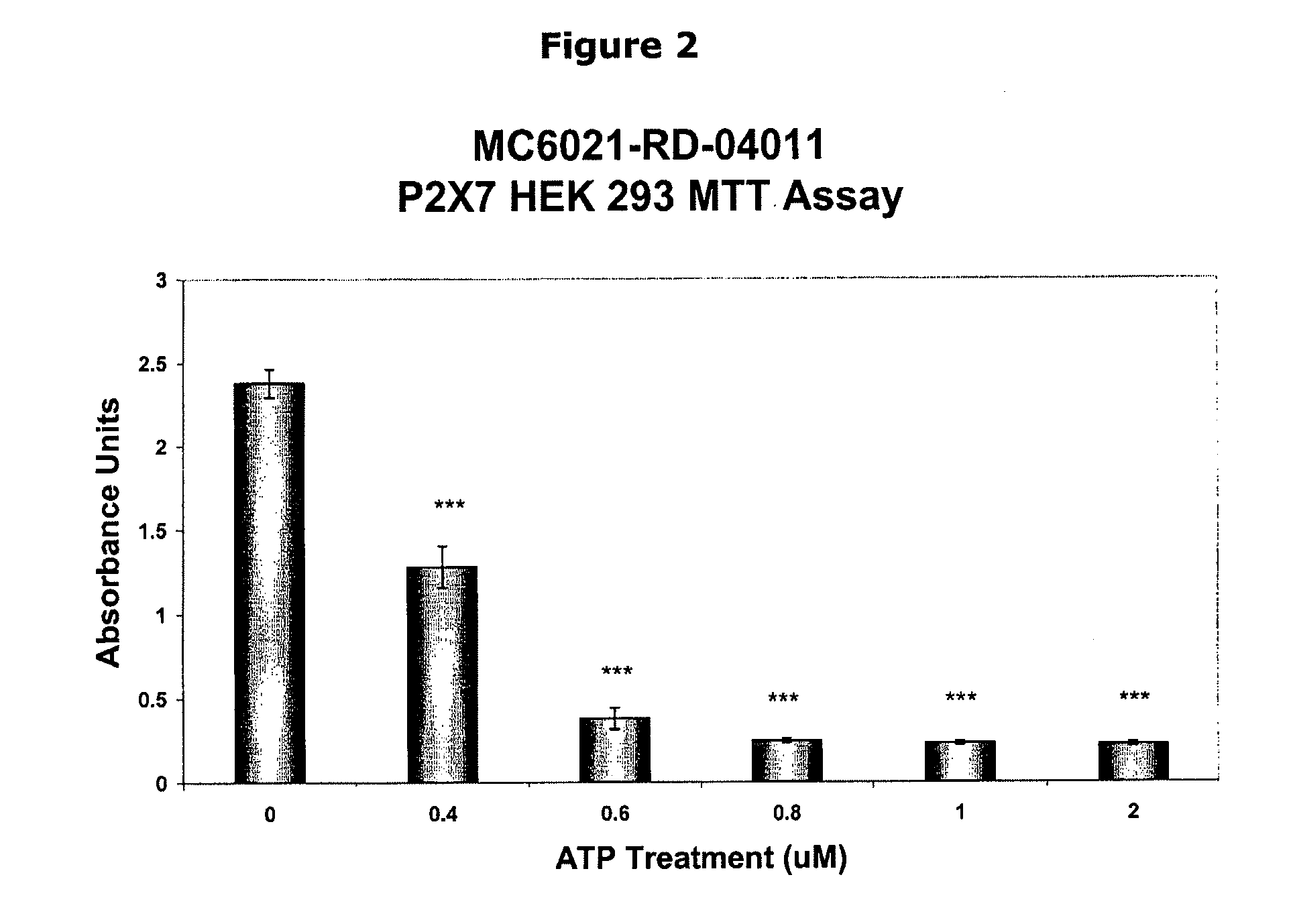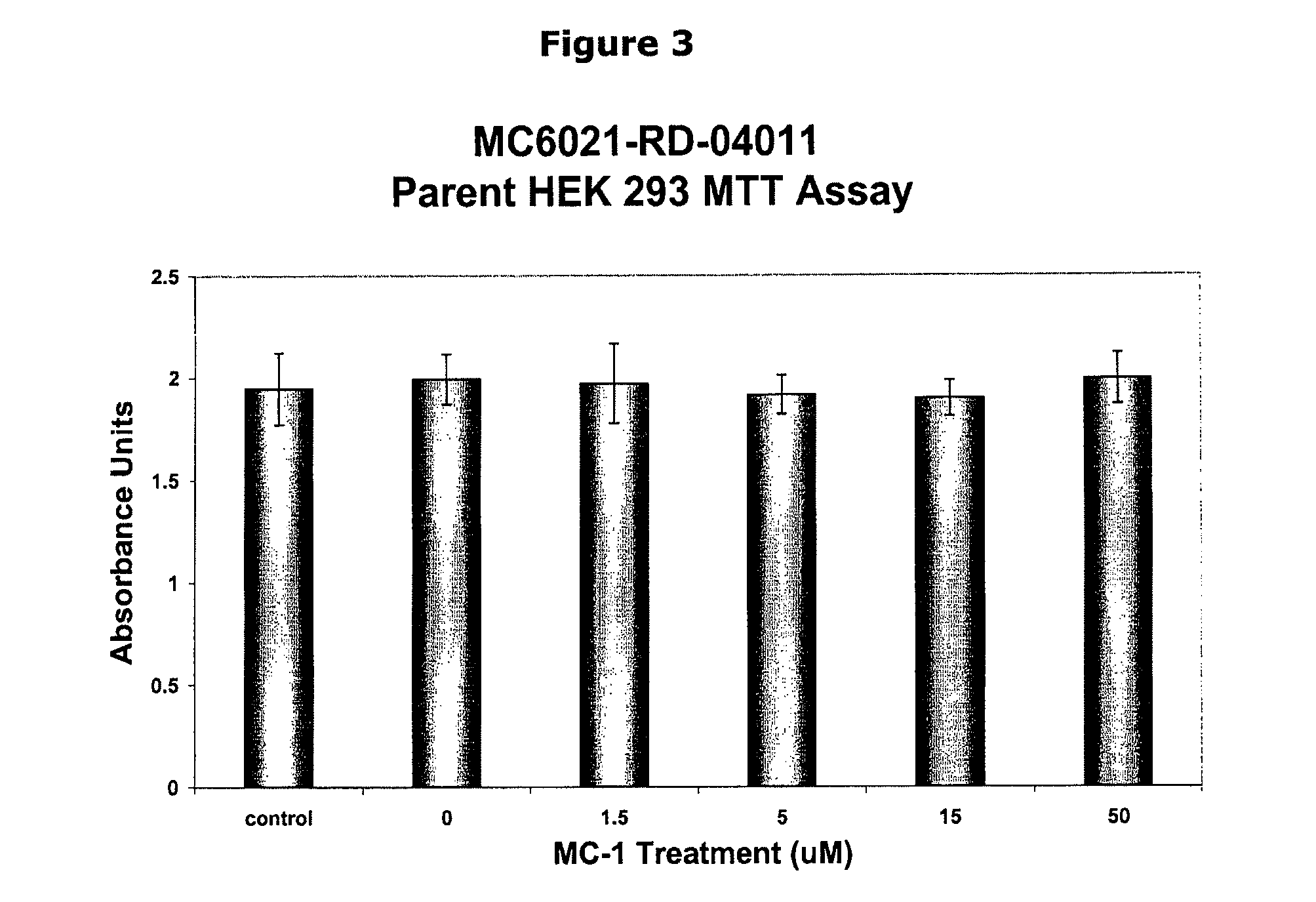Inhibition of atp-mediated, p2x7 dependent pathways by pyridoxal-5-phosphate and vitamin b6 related compounds
a pyridoxal 5-phosphate and pyridoxal 5-phosphate technology, applied in the direction of biocide, drug composition, animal husbandry, etc., can solve the problems of abscess formation, chronic wound formation, tissue damage, etc., and achieve the effect of increasing the level of il-1
- Summary
- Abstract
- Description
- Claims
- Application Information
AI Technical Summary
Benefits of technology
Problems solved by technology
Method used
Image
Examples
example 1
Induction of Cell Death in HEK 293 P2X7 (Rat) Cells with ATP
[0074]HEK 293 cells were stably transfected to express rat P2X7 receptor, using standard tissue culture techniques (Surprenant et al, 1996). The cell line was known to not express any of the other P2X receptors (Schachter et al, 1997). Stable expression of P2X7 was confirmed by Western blot (results not shown).
[0075]Parent (HEK 293) cells, and HEK 293 cells expressing rat P2X7 (HEK 293 P2X7 (rat) cells) were treated with ATP (Sigma, A9062) to determine the effects of ATP on the viability of the cells. Cell viability was determined using an MTT assay (Wen, 2003). Cells were treated with between 0 and 2 μM of ATP. MTT was added to the cell cultures 180 minutes after ATP treatment. The MTT assay was performed 60 minutes after the addition of MTT. Cell viability was directly correlatable to the absorbance of 550 nm light by the cell culture, with a higher absorbance meaning higher cell viability. The cell culture media was remo...
example 2
P5P Treatment Protects Cells from ATP-Mediated, P2X7-Dependent Cell Death
[0079]HEK 293 and HEK 293 P2X7 (rat) cells were treated with 0 to 50 μM of P5P, a vitamin B6 related compound, in sodium salt form (Chemistry Department, CanAm Bioresearch Inc.). Thirty minutes later, cells were treated with 0.4 μM ATP, to determine the effects of ATP on the viability of the MC-1 treated cells. Control cells received sham treatment of P5P, and sham treatment of ATP.
[0080]Cell viability was determined using an MTT assay [16]. MTT was added to the cell cultures 180 minutes after ATP treatment. The MTT assay was performed 60 minutes after the addition of MTT. Cell viability was directly correlatable to the absorbance of 550 nm light by the cell culture, with a higher absorbance meaning higher cell viability.
[0081]FIG. 3 shows the cell viability in HEK 293 cells. Control cells received sham treatment of P5P and sham treatment of ATP. Cells in the “0” column received sham treatment of P5P but were t...
example 3
P5P Inhibits ATP-Induced Processing and Release of IL-1β from PMA / LPS Stimulated THP-1 Cells
[0084]THP-1 non-adherent, monocytic cells (ATCC) were pre-treated with phorbol-12-myristate-13-acetate (PMA), which differentiated the cells into macrophage-like cells. Briefly, approximately 8×106 THP-1 cells were harvested, pelleted, resuspended in media to which PMA was added at a final concentration of 0.5 μM. The cells were incubated for 3 hours, then collected, washed, and plated.
[0085]The next day, the cells were treated with lipopolysaccharide (LPS) to stimulate IL-1β production. Briefly, the media was removed and replaced with RPI media+10% fetal calf serum containing 100 ng / ml of LPS. Cells were incubated for an additional 24 hours.
[0086]Media was then changed, and the test compound (pyridoxine phosphate, pyridoxal, P5P, pyridoxamine, or pyridoxamine phosphate) was added to a final concentration of 0, 0.5, 1.5, 5, 15, 50 or 150 μM. Cells were pretreated for 30 minutes, then the medi...
PUM
| Property | Measurement | Unit |
|---|---|---|
| Cell angle | aaaaa | aaaaa |
| Level | aaaaa | aaaaa |
| Body weight | aaaaa | aaaaa |
Abstract
Description
Claims
Application Information
 Login to View More
Login to View More - R&D
- Intellectual Property
- Life Sciences
- Materials
- Tech Scout
- Unparalleled Data Quality
- Higher Quality Content
- 60% Fewer Hallucinations
Browse by: Latest US Patents, China's latest patents, Technical Efficacy Thesaurus, Application Domain, Technology Topic, Popular Technical Reports.
© 2025 PatSnap. All rights reserved.Legal|Privacy policy|Modern Slavery Act Transparency Statement|Sitemap|About US| Contact US: help@patsnap.com



